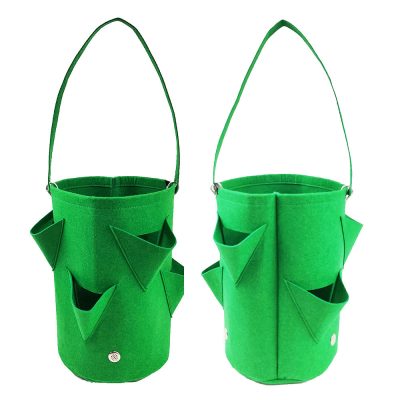To maximize plant health and productivity in hanging grow bags, consider implementing the following strategies:
- Proper Plant Selection: Choose plants that are well-suited for hanging conditions and compact in size. Look for trailing or cascading varieties, dwarf varieties, or plants with shallow root systems. Herbs, strawberries, cherry tomatoes, trailing flowers, and leafy greens are excellent choices for hanging grow bags.
- Quality Potting Mix: Use a high-quality potting mix specifically formulated for container gardening. Avoid using garden soil, as it can be heavy and may not provide adequate drainage. The potting mix should be well-draining, nutrient-rich, and lightweight.
- Adequate Drainage: Ensure that the hanging grow bags have sufficient drainage holes at the bottom. Proper drainage is crucial to prevent waterlogging, which can lead to root rot. If necessary, add additional drainage holes to improve water drainage.
- Watering and Moisture Management: Monitor the moisture level of the potting mix regularly and water as needed. Hanging grow bags may dry out more quickly than traditional pots, so it’s important to check the moisture level frequently. Water the plants thoroughly when watering and allow excess water to drain out.
- Fertilization: Apply a balanced, water-soluble fertilizer at regular intervals to provide essential nutrients for plant growth. Follow the instructions on the fertilizer packaging for the appropriate application rate and frequency. Nutrient needs may be higher for plants in containers, so regular fertilization is important for optimal growth and productivity.
- Sunlight and Placement: Place the hanging grow bags in a location that receives the appropriate amount of sunlight for your plants’ needs. Most plants require at least six hours of direct sunlight per day. Adjust the hanging height or location as needed to optimize sunlight exposure. Consider the specific light requirements of each plant when arranging the hanging grow bags.
- Pruning and Training: Regularly prune and trim your plants to maintain their shape and promote healthy growth. This includes removing dead or yellowing leaves, pinching back leggy growth, and trimming excess foliage. For vining plants, train the vines along supports or trellises to control growth and encourage productivity.
- Pests and Disease Management: Regularly inspect your plants for signs of pests or diseases. Common pests include aphids, spider mites, and whiteflies. If detected, take appropriate measures to control them, such as using organic insecticides or employing natural pest control methods. Ensure proper air circulation around the hanging grow bags to minimize the risk of fungal diseases.
- Regular Maintenance: Check the hanging grow bags regularly for any signs of wear or damage. Replace any worn-out or torn bags to maintain the structural integrity. Clean the hanging grow bags between planting seasons to prevent the buildup of pathogens or pests.
- Harvesting and Succession Planting: Harvest crops regularly to encourage continued productivity. Remove mature fruits, vegetables, or herbs to promote further growth and encourage the development of new flowers or fruit. Consider implementing succession planting by replanting new seedlings or crops as others are harvested, ensuring a continuous supply of fresh produce.
By implementing these strategies, you can optimize plant health and productivity in your hanging grow bags, resulting in vibrant, productive, and thriving plants.








